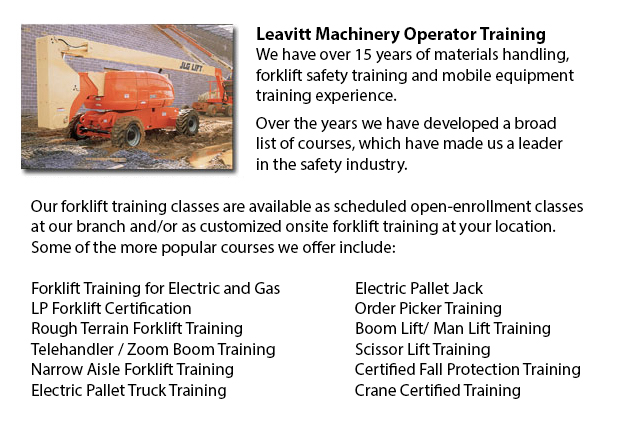
Nanaimo Boom Lift Safey Training - Boom lifts are a kind of aerial lifting device or elevated work platform which are commonly used in industry, warehousing and construction. Boom lifts could be utilized in practically whichever environment because of their versatility.
The elevated work platform is used to enable access to heights which were otherwise inaccessible making use of other means. There are risks inherent when utilizing a boom lift device. Employees who operate them must be trained in the correct operating techniques. Avoiding accidents is vital.
Boom Lift Training Programs cover the safety factors involved in using boom lifts. The program is suitable for individuals who operate self-propelled elevated work platforms and self-propelled boom supported elevated work platforms. Upon successfully finishing the course, Individuals who participated will be issued a certificate by a person who is qualified to confirm the completion of a hands-on assessment.
So as to help train operators in the safe use of elevated work platforms, industry agencies, local and federal regulators, and lift manufacturers all play a role in establishing standards and providing the necessary information. The most essential ways in preventing accidents associated to the use of elevated work platforms are the following: checking equipment, putting on safety gear and performing site assessment.
Important safety factors when operating Boom lifts:
Operators need to observe the minimum safe approach distance (MSAD) from power lines. Voltage can arc across the air to be able to find an easy path to ground.
A telescopic boom should be retracted prior to lowering a work platform to be able to maintain stability when the platform nears the ground.
Boom lift workers should tie off to ensure their safety. The lanyard and safety apparatus have to be connected to manufacturer provided anchorage, and never to other wires or poles. Tying off may or may not be needed in scissor lifts, which depends on specific local regulations, employer guidelines or job risks.
The maximum slope would be specified by the manufacturer. Workers should avoid working on a slope, if possible. When the slope exceeds recommended situation, the lifting device should be winched or transported over the slope. A grade can be measured easily by laying a minimum 3-feet long straight edge or board on the slope. After that a carpenter's level could be laid on the straight edge and the end raised until it is level. The per-cent slope is obtained by measuring the distance to the ground (likewise called the rise) and dividing the rise by the length of the straight edge. Then multiply by 100.
-
Nanaimo Boom Lift Certification
Nanaimo Boom Lift Certification - Using elevated work platforms allow for maintenance operations and work to be carried out at elevated work heights which were otherwise not reachable. Workers making use of scissor lifts and boom lifts can learn how... More -
Nanaimo Loader Operator Training
Nanaimo Loader Operator Training - Loader Operator Training - Forklift training is a prerequisite within North America and is intended to prevent workplace death and injuries. Lift truck training provides driver training intended for forklift operato... More -
Fall Protection Certification in Nanaimo
There are high numbers of injuries at work associated to falling and lots of fall-related deaths reported each and every year. Most of these instances might have been prevented with better training, better measures in place, and by properly equipping... More -
Nanaimo Crane Ticket
Nanaimo Crane Ticket - The modern version of a crane can be either complex or simple, and cranes vary based on their use. Mobile cranes, for example are rather simple. A telescopic boom or steel truss mounts its movable platform. A system of levers o... More -
Operator Safety Certification | Re-Qualification Certification | In-House Instructor Certification in Nanaimo
Lift trucks are used in practically all industrial construction sites and in warehouse operations and in boat yards. The reach feature of a forklift is a very important part utilized in several applications like when a shelving system is being used t... More -
Aerial Lift / Boom Lift / Man Lift / Scissor Lift Certification in Nanaimo
Scissor hoists are lift tables which lift up materials and individuals and supplies vertically. They are normally used in construction, commercial and industrial environments. A common use of scissor hoists is for lowering or lifting construction sup... More -
Crane / Overhead Crane / Self-Erect Crane / Truck Mounted Crane / Hydraulic Cranes Certification in Nanaimo
Bridge cranes or likewise called overhead cranes are a type of industrial material handling crane utilizing a line and hook apparatus that runs on a horizontal beam running along two widely separated rails. Several overhead cranes can be seen inside... More -
Nanaimo Warehouse Forklift Safety Training
Nanaimo Warehouse Forklift Safety Training - The business will face claims for liability when injuries and damage are sustained in an accident at the workplace. Warehouses could be a dangerous place to work for its employees, making employee safety a... More

Forklift Certification Nanaimo
TOLL FREE: 1-888-254-6157
Nanaimo, British Columbia
forkliftcertificationnanaimo.com
Email Us
About Us


